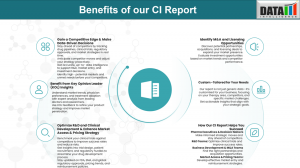Mucopolysaccharidosis Type I: Strategic Shift Underway as Gene Therapies &and Next-Gen ERTs Challenge Market Dominance
MPS I market evolution accelerates as gene therapies and BBB-penetrant ERTs emerge, challenging Sanofi’s Aldurazyme in a high-value orphan space.
Download CI Sample Report: https://www.datamintelligence.com/strategic-insights/sample/mucopolysaccharidosis-type-i-mps-i-treatment-revolution-the-role-of-innovative-gene-therapy-in-addressing-unmet-needs
Understanding MPS I: A Devastating Rare Disease
MPS I is a progressive genetic disorder caused by a deficiency in the alpha-L-iduronidase enzyme (IDUA), leading to the accumulation of glycosaminoglycans (GAGs) in tissues and organs. This buildup manifests as skeletal deformities, cardiopulmonary complications, hepatosplenomegaly, corneal clouding, and in severe cases, neurocognitive decline. MPS I is classified into three clinical subtypes based on severity: Hurler syndrome (MPS-IH), Hurler-Scheie syndrome (MPS-IHS), and Scheie syndrome (MPS-IS).
The disorder affects approximately 1 in 100,000 live births, with equal distribution among males and females and across ethnicities. Despite its rarity, the disease burden is immense and life-limiting, especially for children with Hurler syndrome who, if untreated, rarely survive beyond their first decade.
Current Standard of Care: A Narrow and Imperfect Option
Enzyme Replacement Therapy (ERT) and Stem Cell Transplantation (SCT) form the current therapeutic backbone for MPS I. Aldurazyme (laronidase), the only FDA-approved ERT, provides systemic benefits by supplementing the deficient enzyme via weekly intravenous infusions. While effective in addressing somatic symptoms, Aldurazyme fails to cross the blood-brain barrier (BBB), leaving CNS manifestations largely untreated.
SCT, although capable of delivering some degree of neuroprotection, carries substantial risks, including graft-versus-host disease, morbidity, and limited donor availability. Due to these limitations, the demand for next-generation therapies with both systemic and CNS benefits is rising sharply.
Pipeline Analysis: A Future Driven by Innovation
The MPS I pipeline is robust, populated by novel gene therapies, BBB-penetrating biologics, and long-acting ERTs. Several biotech and pharma companies are investing aggressively in first-in-class treatments that aim to correct the genetic defect at its source or deliver the deficient enzyme directly into the CNS.
Key developments include:
- Gene Therapies: AAV-based and lentiviral vector platforms designed for single-dose administration, potentially curative with systemic and neurological efficacy.
- Hematopoietic Stem Cell (HSC) Gene Editing: Leveraging autologous stem cells modified ex vivo to express IDUA, aiming for durable enzyme expression.
- BBB-Penetrant ERTs: Fusion proteins and receptor-mediated transport technology now make it feasible for ERTs to cross into the brain, tackling the neurocognitive component of MPS I.
These programs are currently in mid-to-late-stage clinical trials with anticipated approvals in the next 4–6 years. If successful, they could transform the treatment paradigm and significantly reduce patient burden and healthcare costs.
Competitive Landscape: Aldurazyme Under Siege
Sanofi, the developer of Aldurazyme, faces an imminent challenge as emerging competitors develop therapies with superior efficacy, route of administration, and durability. With Aldurazyme priced between $200,000 and $500,000 annually and requiring lifelong weekly infusions, market access teams across biotech are eyeing an opportunity to introduce value-based, next-gen therapies that justify premium pricing through long-term benefits and CNS impact.
The key to dethroning Aldurazyme lies in addressing its core shortcomings:
- CNS Inaccessibility: New therapies that cross the BBB or deliver enzyme directly into cerebrospinal fluid will gain significant traction.
- High Treatment Burden: Less frequent dosing—monthly or even one-time treatments—will appeal to physicians, patients, and payers alike.
- Lac of Durability: Gene therapies and edited HSCs offer long-term, possibly permanent solutions versus lifelong IV infusions.
Strategic Insights and Market Positioning
The MPS I market is poised for fragmentation and innovation-led disruption. While gene therapies represent the ultimate goal—a one-time, curative treatment—they face challenges in cost-effectiveness, delivery, and long-term safety data. As a result, BBB-penetrant ERTs are emerging as a promising near-term solution, potentially bridging the gap until gene therapies reach maturity.
In this evolving space, successful market entrants will need to demonstrate:
- Tangible CNS benefit alongside systemic efficacy
- Lower administration frequency and improved convenience
- Compelling safety and immunogenicity profile
- Cost-effectiveness, particularly in orphan pricing frameworks
Target Opportunity Profile (TOP): Defining Success in the MPS I Space
To displace Aldurazyme, pipeline candidates must outperform on both clinical and commercial dimensions. The most attractive target product profile includes:
- Mechanism: CNS-active gene therapy or BBB-penetrating ERT
- Efficacy: Demonstrable improvement in both somatic and neurocognitive domains
- Safety: Lower immunogenicity, minimal toxicity
- Dosing Convenience: Single-dose or infrequent administration
- Pricing Justification: Premium, value-based pricing linked to long-term benefit
Key Players and Strategic Alliances
Emerging biotech companies specializing in gene therapy and protein engineering, such as REGENXBIO, Orchard Therapeutics, and Denali Therapeutics, are gaining momentum in this space. Their focus on differentiated technology platforms and CNS-targeted delivery positions them as strong contenders to redefine the standard of care.
Book Your Free CI Consultation Call: https://www.datamintelligence.com/strategic-insights/ci/mucopolysaccharidosis-type-i-mps-i-treatment-revolution-the-role-of-innovative-gene-therapy-in-addressing-unmet-needs
Conclusion: A Market on the Brink of Transformation
The MPS I landscape stands at a crossroads. While Aldurazyme has offered a vital lifeline for nearly two decades, it falls short in key areas that modern therapies are primed to address. With gene therapies nearing late-stage development and innovative ERTs that overcome CNS barriers, the coming years will likely reshape the therapeutic and commercial outlook for MPS I.
For biopharma companies, payers, and healthcare providers, the imperative is clear: adapt to a changing market where differentiation, durability, and real-world impact define success. The winners in this race will not just alleviate symptoms—they will redefine what’s possible for MPS I patients worldwide.
Read Related CI Report:
1. Friedreichs Ataxia Disease Modifying Therapies
2. Cell and Gene Therapy | Competitive Intelligence
Sai Kiran
DataM Intelligence 4market Research LLP
877-441-4866
email us here
Visit us on social media:
LinkedIn
X
Legal Disclaimer:
EIN Presswire provides this news content "as is" without warranty of any kind. We do not accept any responsibility or liability for the accuracy, content, images, videos, licenses, completeness, legality, or reliability of the information contained in this article. If you have any complaints or copyright issues related to this article, kindly contact the author above.
Teacher / Nurse Next Door Buyers Secure Seller Concessions at Twice the National Average
carbmee Expands Unified Sustainability Offering with the Release of AI-Powered EUDR Solution
Health 2.0 Conference’s Dubai 2025 Edition To Investigate Healthcare Fraud Schemes
Kalendarium
Więcej ważnych informacji
 Jedynka Newserii
Jedynka Newserii

 Jedynka Newserii
Jedynka Newserii

Finanse

Uchodźcy z Ukrainy pomogli wygenerować 2,7 proc. PKB Polski w 2024 roku. Napływ nowych pracowników znacznie zmienił polski rynek pracy
Uchodźcy z Ukrainy coraz lepiej radzą sobie na polskim rynku pracy – pracuje 69 proc. z nich – wynika z najnowszego badania przeprowadzonego przez Deloitte dla UNHCR. Jednocześnie wciąż w tym obszarze jest wiele wyzwań, w tym bariery językowe czy kwestie dotyczące uznawania kwalifikacji, np. w zawodach medycznych i prawniczych. Na rosnącej aktywności zawodowej Ukraińców mocno skorzystała polska gospodarka, ale też sam rynek pracy: wzrosła konkurencja, a Polacy uzyskali możliwość specjalizacji i objęcia stanowisk menedżerskich, eksperckich i technicznych.
Ochrona środowiska
W UE wciąż więcej kontroli działań firm w ramach ESG niż zachęt. Konieczne jest złagodzenie podejścia

Instytucje unijne powinny bardziej koncentrować się na celach i możliwościach rozwoju, jakie daje ESG, a nie kontroli działań firm w tym obszarze i obowiązków sprawozdawczych – twierdzą przedstawiciele organizacji Business for Good. Konieczne jest więc złagodzenie obowiązujących regulacji. Europa powinna również dążyć do utworzenia wspólnego rynku o ujednoliconych przepisach i mechanizmach.
Konsument
Wakacje wyzwaniem dla operatorów komórkowych. W najpopularniejszych kurortach ruch w sieci rośnie nawet pięciokrotnie

Długie weekendy i wakacje to wymagający czas dla operatorów komórkowych. W najbardziej obleganych kurortach udział abonentów tylko sieci Play w stosunku do liczby mieszkańców przekracza 500 proc. Dlatego operator planuje dalszą rozbudowę swojej sieci komórkowej do minimum ponad 15 tys. stacji bazowych. W latach 2020–2024 Play zainwestował w sieć i częstotliwość ponad 6 mld zł.
Partner serwisu
Szkolenia

Akademia Newserii
Akademia Newserii to projekt, w ramach którego najlepsi polscy dziennikarze biznesowi, giełdowi oraz lifestylowi, a także szkoleniowcy z wieloletnim doświadczeniem dzielą się swoją wiedzą nt. pracy z mediami.








.gif)

 |
| |
| |
|